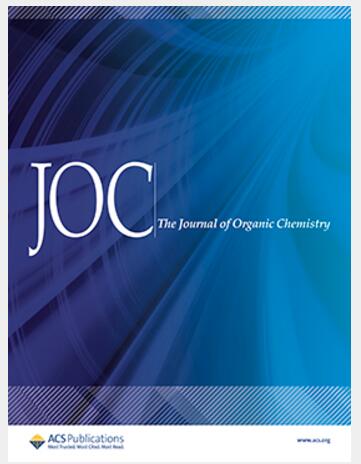All-E-Carotenoid Synthesis via Suzuki Coupling of α,ω-Dibromopentaene: HPLC Optimization of the Catalytic Reaction Conditions.
IF 3.6
2区 化学
Q1 CHEMISTRY, ORGANIC
引用次数: 0
Abstract
C12 all-E-1,10-dibromo-3,8-dimethyldeca-1,3,5,7,9-pentaene (5) was prepared by double Ramirez dibromo-olefination of readily available C10 all-E-2,7-dimethylocta-2,4,6-trienedial (3) using CBr4 and PPh3, followed by the Hirao reduction of gem-dibromide using dimethyl phosphite and Et3N. The bidirectional double Suzuki coupling of 5 with C14 boronic acid pinacol esters (B-Pin) derived from various ionones or cinnamaldehyde produced all-E-β-carotene 1a, all-E-lycopene 1b, all-E-isozeaxanthin 1c, and all-E-phenyl-carotene 1d in high yields. The optimized catalytic reaction condition was determined by controlling the relative rate of each step in the cross-coupling mechanism by varying the base, solvents, and Pd catalyst, including the ligand. Information about the relative rate of each step was obtained from the reaction profiles generated from HPLC chromatograms over the reaction time. The double Suzuki coupling reaction is best suited for the synthesis of symmetrical all-E-carotenoids, whereas the Z-carotene prepared from the corresponding Z,Z-dibromopentaene 7 readily isomerizes to afford a mixture of stereoisomers. The generality of the Suzuki coupling reaction of dibromopentaene 5 was demonstrated by the concise and high-yield syntheses of short all-E-aryl-carotenoids 20-27 with various aryl boronic acids.α,ω-二溴戊烯铃木偶联合成全e类胡萝卜素:高效液相色谱法优化催化反应条件。
以CBr4和PPh3为原料,采用双拉米雷兹双溴化法制备了C10 all- e -1,10-二溴-3,8-二甲基十烷-1,3,5,7,9-戊烯(5),然后用亚磷酸二甲酯和Et3N进行了Hirao还原,得到了C10 all- e -2,7-二甲基-2,4,6-三烯二醛(3)。5与从各种离子或肉桂醛中提取的C14硼酸松醇酯(B-Pin)的双向双铃木偶联可以高产地生产出全e -β-胡萝卜素1a、全e -番茄红素1b、全e -异玉米黄质1c和全e -苯基胡萝卜素1d。通过改变碱、溶剂、钯催化剂(包括配体)等因素来控制交叉偶联机制中各步骤的相对速率,确定了优化的催化反应条件。每个步骤的相对速率信息是通过HPLC色谱图在反应时间内生成的反应谱获得的。双Suzuki偶联反应最适合合成对称的全e -类胡萝卜素,而由相应的Z,Z-二溴戊烯7制备的Z-胡萝卜素很容易异构化,形成立体异构体的混合物。二溴戊烯5铃木偶联反应的通用性通过以各种芳基硼酸为原料合成短的全e -芳基类胡萝卜素20-27得到验证。
本文章由计算机程序翻译,如有差异,请以英文原文为准。
求助全文
约1分钟内获得全文
求助全文
来源期刊

Journal of Organic Chemistry
化学-有机化学
CiteScore
6.20
自引率
11.10%
发文量
1467
审稿时长
2 months
期刊介绍:
Journal of Organic Chemistry welcomes original contributions of fundamental research in all branches of the theory and practice of organic chemistry. In selecting manuscripts for publication, the editors place emphasis on the quality and novelty of the work, as well as the breadth of interest to the organic chemistry community.
 求助内容:
求助内容: 应助结果提醒方式:
应助结果提醒方式:


